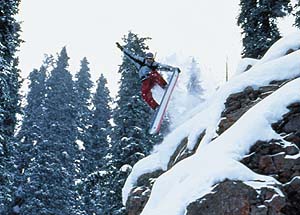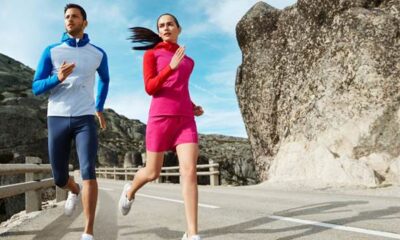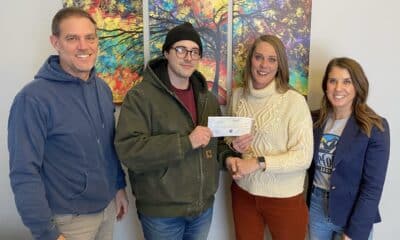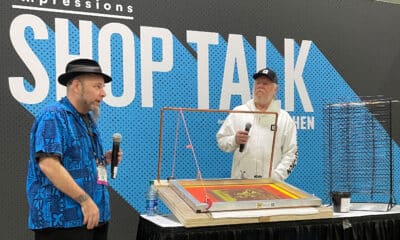Articles
Published
24 years agoon

Standing high on Crystal Mountain, nearly 5000 ft of powder beneath her feet, Heidi McCory has a breathtaking view of Washington State’s Cascade range. Inching towards the steep mountainside, she checks her gear, pushes off on her Luna snowboard, and drops down the mountain in an adrenaline-filled rush. Surfing through a maze of evergreens and embankments, she takes her board to the limits, feeling the Luna’s form, function, and funkiness.
McCory is “working” today, and the mountain is her “office.” As marketing manager of K2 Corp., one of the world’s premier manufacturers and decorators of snowboards and skis, part of her job is informally testing company products in the field…or rather, on the slopes.
With job perks like this, it’s clear that K2 is not your typical screen-printing shop. Though the company uses traditional screen-printing methods in producing skis, snowboards, and other sporting goods, the rest of its philosophies are anything but conventional. K2 refuses to fit the typical business mold, whether it’s in the unique fringe benefits it offers employees, the choice location of its plant, the quality of its products, or its market leadership. The unconventional mindset keeps the company at the cutting edge of its industry and talented job applicants camped out at its front door. Fantasy, you say? More like Fantasy Island.
Climbing to the top
Located on Washington’s Vashon Island in Puget Sound, yet just ten miles from downtown Seattle, K2 is both a rural shop and a major metropolitan corporation. The island–accessible only by daytime ferry service–might seem like an isolated place for such a company, and would present insurmountable difficulties with mail, shipping, employee commuting, etc., but K2 has thrived. “The company has done very well on Vashon, and most of the people like being out here,” says James Fitzgerald, K2’s screen-printing quality technician. “It really is a way of life.”
K2 traces its origins back to the late 1940s, when brothers Bill and Don Kirschner enjoyed success on the island as Kirschner Manufacturing Co., making fiberglass animal kennels and splints. Business was good, but the brothers were always looking for more.
A new opportunity presented itself on the slopes of nearby mountain ranges. Like most Northwesterners, the Kirschners had developed a special relationship with the great outdoors, and a particular fondness for the Cascade and Olympic Mountains. It was there that Bill recognized the growing popularity of skiing and saw that the raw materials used in skis and kennels weren’t that different.
In 1961, using a borrowed pair of skis for a pattern, Bill manufactured his first pair of fiberglass skis. They were such a success that Bill approached Anderson & Thompsom (A&T) Ski Co., a Seattle distributor of ski equipment, with his idea for a corporate partnership. An agreement was reached, and in 1964, Kirschner Manufacturing delivered its first order of skis–250 pairs, followed the next year by 1,600 pairs. It soon became obvious that the ski business could stand on its own, so Bill separated it from Kirschner Manufacturing, and named the new company K2 (after the world’s second-tallest mountain and for the two Kirschner brothers).1969, K2 was selling 21,000 pairs of skis per year, and its staff had grown from Bill, Don, and a single machinist to 83 employees. About this time, K2 ended its arrangement with A&T to create its own distribution and marketing channels and establish itself as producer of world-class racing skis. As with Bill’s first skis, the new racing skis were an instant success, becoming the first American-made skis ever to win a World Cup race. The quality and reputation of its products kept K2 growing quickly through a series of acquisitions and mergers during the ’70s and ’80s.
In 1985, Los Angeles-based Anthony Industries became K2’s new parent company. The large conglomerate had manufacturing operations for a range of products including fishing tackle, swimming pools, athletic wear, life vests, and mountain bikes, all marketed under different names. K2’s name was well-known and firmly established by this point, so instead of the smaller company taking on the parent company name, the reverse happened–Anthony Industries became K2 Inc.
The acquisition gave K2 Corp. the resources it needed to expand and modernize its production facilities and equipment, improve process control, and develop “just-in-time” manufacturing techniques. And with the introduction of snowboards in 1988, alpine skis in 1990, and inline skates in 1993, K2 has become a dominant force in North American ski and snowboard production and a major player in the world sporting-goods industry.
K2 Corp. operates from two separate buildings on Vashon Island. The first houses the company’s marketing, sales, and corporate administration offices, while the other has 30,000 sq ft devoted to manufacturing and printing.
K2’s snowboards and skis are produced in a multistep process. First, the body of the board or ski is manufactured from wood encased in fiberglass. Next, graphics are printed on polyester or a similar film, which is then thermally laminated to the body of the product. Finally, the board or ski goes through finishing, where it is sanded and polished, and in some cases, fitted with bindings and other accessories.
“In the beginning, most printing on the skis was just a simple ‘K2’ logo on the top of the skis, and that printing was outsourced,” Fitzgerald says. “It wasn’t until the late 1970s that K2 established its own in-house printing department, and it really took off after that.”
K2’s printing operation is a marvel of efficiency and democracy, beginning in the art room and continuing through each step of production. The company begins by generating color digital proofs of a design. Once the proofs are printed, they are circulated for everyone in the shop to see and provide feedback. Any employee from any department can comment anonymously and make suggestions about any part of the design.
Once the design is approved and refined, film positives are produced for screenmaking. The company has standardized film output and screen sizes, so a film positive for skis contains four images, while a wider snowboard positive contains only one. The screens, which all feature rigid aluminum frames measuring 4 x 9 ft, are coated and exposed on automated equipment. After printing, the screens are cleaned or reclaimed manually.
Virtually all snowboards (Figure 1) and skis (Figure 2) receive an image on their top surface, but many also incorporate images on the bottom. The images are generally spot-color designs, but about 10% of the company’s skis and 30% of its snowboards feature process-color graphics.
To print the graphics, the shop uses six semi-automatic sheet-fed presses (Figure 3). UV inks are used for 95% of the jobs, while sublimation inks and solvent-based formulations make up the remainder. The shop’s inkroom shares floor space with the pressroom, primarily to reflect and maintain the inkroom’s importance in the printing process.
Images are printed second surface onto polyester sheets. The unprinted surface of the polyester film becomes the outside surface of the product after the film is laminated to the core of the board or ski (Figure 4). The skis and snowboards are then sent on for finishing.
K2’s print production schedule covers two shifts, each with 50-60 employees (the company has about 640 people overall). Because of the skill of its employees, K2 can churn out up to 25,000 prints per week for snowboards, skis, or a combination of both.
Despite its high-volume production and its remote location, shipping products to the mainland goes pretty smoothly. “K2 just assumes the costs of shipping off the island,” says Sanders Nye, K2 snowboard product manager. “At this point, packing up the facility on Vashon and moving K2 to the mainland would just be too expensive, especially if we were to move into nearby Seattle, where property rates are much higher.”
Performance and testing
By nature, skis and snowboards are subjected to a variety of abusive conditions, including sun, snow, ice, rocks, tree branches, crashes, stunts, and more. But the most destructive force they face is radical temperature fluctuations. It’s not uncommon for skis or boards that have been exposed to freezing mountaintops one moment to end up on boiling car roof racks a short time later. K2 engineers are challenged to design products that will withstand these conditions without peeling, cracking, or fading.
The most visible sign of a defective or aging snowboard or ski is “delamination” of the graphic film layer from the outside of the product. All ski and snowboard manufactures face this problem, but K2 has found a way to create and sustain lamination and graphic quality through a closely guarded process it developed.
For a ski or snowboard to make the grade, it must pass temperature tests in which it is subjected to freezing cold and extreme heat in rapid succession. It must also pass K2’s “30-lb weight test,” a proprietary procedure designed to ensure a strong bond between the laminated graphic film and the ski or snowboard.
Real-world tests are also part of the K2 program. “We’ll go all over to Mt. Hood, up into the Olympics, and other places,” McCory says. “This year, we were lucky enough to all go up to Mt. Rainier. During the winter, there is Crystal Mountain and Mt. Baker, and we have all kinds of other opportunities to get out there in the field. Because we are in the foothills of the Cascades, we have the opportunity for year-round testing that you really couldn’t do in New England or many other places.”
K2 prides itself on the fact that everyone at the company has say in design, manufacturing, and testing of products. And they probably should, because not only are K2 employees top-notch artists, printers, and engineers, they are accomplished skiers, snowboarders, and advocates of extreme sports. K2 employees are the company’s best customers, and it shows.
“We’re pretty serious here about what we do,” McCory explains. “We take the time to make sure that we put out items that will not only sell, but will perform well, too. And we have a great staff that can do it.”
If you are at all familiar with snowboarding or skiing, then you are probably aware of K2’s reputation for quality products. And K2 is intimately familiar with the attitude and lifestyle that accompany snowboarding and skiing. To maintain its edge, K2 promotes participation in these sports by allowing employees to “call in well” and take to the slopes. The company also sponsors skiing and boarding teams that include riders like 1988 U.S. Extreme Snowboarding champion Gareth Van Dyk.
In addition to hiring employees who know the sport well, K2 also gets inspiration for new and improved products by continually conducting focus groups from coast to coast that cover everything from product construction and dynamics to design and marketing. The efforts have paid off for K2, which pioneered such products as wide boards, mid-flex board designs, step-in bindings, and electronic damping (to maintain smooth rides at high speeds). Competitors are never far behind, so K2 remains diligent in researching new technology. Its approach to graphic design is much the same.
“We contract out art design to 12 freelance artists,” explains Nick Sherman, K2 graphics coordinator. “We give them a little direction, as far as what kind of market we’re aiming at for the board, what kind of board it is, etc. But the rest is up to them.”
K2 considers a number of factors when commissioning new designs. The company has separate marketing strategies for the teenagers, young professionals, and upper-income markets. They market skis differently than boards, and within either product group, market particular product lines differently. “We even market differently within the same demographic group, depending on where they live (state, region, or even country) what kind of riding they do (casual, professional, competitive, or stunts) and where they buy the board,” Sherman explains.
“We have a very good forecast of the demand that’s coming at us–sometimes 3 or 4 months in advance–and on what we’ll produce and how we’ll produce it,” Fitzgerald says. “This also gives us lead time to organize staffing and raw materials. The greatest challenge for our shop and our printers is constantly ‘wowing’ people with effects and improving upon last year’s printing, both from a design and production standpoint.” Knowing about a new product line in advance lets K2 plan the design for maximum impact.
“Images sell boards,” Sherman says. “Uniqueness and hipness is part of the market, especially if you’re selling to experienced and more frequent riders who are more in touch with the sport.” K2 maintains a range of distinct designs for each of its six snowboard lines and four ski lines, including approximately 300 designs for skis and 175 for snowboards. The designs are targeted at specific markets and customer demographics. For example, snowboards going to a Dayton, OH department store will have a much less radical design than the same board sold at Stoner’s Mountainside Shed at the foot of Death Mountain, Colorado.
Much of K2’s new product development goes into snowboards, but skis are still an import item for the company. “Skiing is a mature sport, but not without new surprises,” Nye says. For example, K2 recently began producing “Telemark” skis, which free the user’s heel from the skis (conventional skis keep your heels locked into place) and create a new range of control options for users.
But snowboards are currently the company’s hottest product. Last year, for the first time, K2’s snowboards division outsold its skis group. The growing popularity of the sport is due, in part, to new athletic events, such as the X Games for extreme sports, and the addition of snowboarding events to the last Winter Olympics.
K2 maintains individual Websites for each of its product families, but sells no products online. Instead, it directs buyers to authorized K2 dealers around the world. K2 is represented in many major sporting-goods chains, but also sells through smaller, independent stores. As Sherman explains, “We have a special place for Mom and Pop stores. They grew K2.”
Keeping the edge
The current snowboarding craze is a good example of the company’s skill in understanding, anticipating, and even creating market demands. “I was a skier for 18 years before I tried a board,” Nye confesses. “After that, I was hooked. Snowboarding is more spiritual than skiing. If you listen, people talk about boarding in much the same way surfers talk about surfing. Maybe its because the ride is so much different than skiing. Perhaps its because the sport is relatively new. Whatever it is, its there, and if you’ve ever ridden a board, you feel it.”
With its dedicated staff, skilled engineering, and high-quality production processes, K2 has captured such emotions in all of its products. And by doing so, it has created a loyal following among winter-sports enthusiasts around the world.

Subscribe

Magazine
Get the most important news
and business ideas from Screenprinting Magazine.
Most Popular
-

 Columns1 month ago
Columns1 month ago8 Marketing Mistakes Not to Make When Promoting Your Screen Printing Services Online
-

 Press Releases1 month ago
Press Releases1 month agoSports Inspired Clothing Market: The Influence of Sports on Fashion Forward Looks
-

 Editor's Note1 month ago
Editor's Note1 month agoLivin’ the High Life
-

 Marshall Atkinson1 month ago
Marshall Atkinson1 month agoHow to Create a Winning Culture in Your Screen-Printing Business
-

 Press Releases4 weeks ago
Press Releases4 weeks agoHope Harbor to Receive Donation from BlueCotton’s 2024 Mary Ruth King Award Recipient
-

 Case Studies1 month ago
Case Studies1 month agoScreen Printing for Texture and Depth
-

 News & Trends2 months ago
News & Trends2 months agoWhat Are ZALPHAS and How Can You Serve Them in Your Print Business?
-

 Headlines1 month ago
Headlines1 month agoLive Poster Printing Raises $30K for Charity






